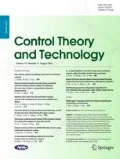Abstract
Due to the limitation of energy resources, energy efficiency is a key issue in wireless sensor networks (WSNs). Clustering is proved to be an important way to realize hierarchical topology control, which can improve the scalability and prolong the lifetime of wireless sensor networks. In this paper, an energy-driven unequal clustering protocol (EDUC) for heterogeneous wireless sensor networks is proposed. EDUC includes an unequal clustering algorithm and an energy-driven adaptive cluster head rotation method. The unequal size of clusters can balance the energy consumption among clusters, and the energy-driven cluster head rotation method can achieve the balance of energy consumption among nodes within a cluster, which reduces the waste of energy. Simulation experiments show that EDUC balances the energy consumption well among the cluster heads and prolongs the network lifetime.
Similar content being viewed by others
References
W. R. Heinzelman, A. Chandrakasan, H. Balakrishnan. Energyefficient communication protocol for wireless microsensor networks[ C]//Proceedings of the 33rd Annual Hawaii International Conference on System Sciences. Maui, HI, 2000: 1–10.
O. Younis, S. Fahmy. HEED: A hybrid, energy-efficient, distributed clustering approach for Ad hoc sensor networks[J]. IEEE Transactions on Mobile Computing, 2004, 3(4): 366–379.
M. Liu, J. Cao, G. Chen, et al. EADEEG: An energy-aware data gathering protocol for wireless sensor networks[J]. Journal of Software, 2007, 18(5): 1092–1109.
C. Li, M. Ye, G. Chen, et al. An energy-efficient unequal clustering mechanism for wireless sensor networks[C]//Proceedings of the IEEE International Conference on Mobile Adhoc and Sensor Systems Conference. Washington, 2005: 597–604.
X. Zhou, M. Wu, J. Xu. BPEC: An energy-aware distributed clustering algorithm in WSNs[J]. Journal of Computer Research and Development, 2009, 46(5): 723–730.
Y. Wang, Q. Zhao, D. Zheng. Energy-driven adaptive clustering data collection protocol in wireless sensor networks[C]//Proceedings of the International Conference on Intelligent Mechatronics and Automation. New York: IEEE, 2004: 599–604.
S. Gamwarige, E. Kulasekere. An algorithm for energy driven cluster head rotation in a distributed wireless sensor network[C]//Proceedings of the International Conference on Information and Automation. New York: ACM, 2005: 354–359.
Y. Wu, Z. Chen, Q. Jing, et al. LENO: LEast rotation nearoptimal cluster head rotation strategy in wireless sensor networks[C]//Proceedings of the 21st International Conference on Advanced Networking and Applications. Los Alamitos: IEEE Computer Society, 2007: 195–201.
H. Huang, J. Shen. An energy-driven adaptive cluster head rotation alforithm for wireless sensor networks[J]. Journal of Electronics & Information Technology, 2009, 31(5): 1040–1044.
M. Perillo, C. Zhao, W. R. Heinzelman. An analysis of strategies for mitigating the sensor network hot spot problem[C]//Proceedings of thd 2nd Annual International Conference on Mobile and Ubiquitous Systems: Networking and Services. Los Alamitos: IEEE Computer Society, 2005: 474–478.
X. Wu, G. Chen. The energy hole problem of nonuniform node distribution in wireless sensor networks[J]. Chinese Journal of Computer, 2008, 31(2): 1–9.
S. Soro, W. R. Heinzelman. Prolonging the lifetime of wireless sensor networks via unequal clustering[C]//Proceedings of the 19th IEEE International Parallel and Distributed Processing Symposium. Los Alamitos: IEEE Computer Society, 2005: 236–243.
M. Xiang. Energy efficient clustering algorithm for maximizing lifetime of wireless sensor networks[J]. Aeu-International Journal of Electronics and Communications, 2010, 64(4): 289–298.
S. Gamwarige, E. Kulasekere. Performance analysis of the EDCR algorithm in a distributed wireless sensor network[C]//Proceedings of the International Conference onWireless and Optical Communication Networks. New York: IEEE, 2006: 85–89.
S. Gamwarige, E. Kulasekere. Application of the EDCR algorithm in a cluster based multi-hop wireless sensor network[C]//Proceedings of the International Symposium on Communications and Information Technologies. New York: IEEE, 2006: 303–308.
Author information
Authors and Affiliations
Corresponding author
Additional information
The work was supported by the National Natural Science Foundation of China (No. 60373012, 10871119), the Natural Science Foundation (No. ZR2009GM009, ZR2009AM013), the Promotional Foundation for Middle-aged or Young Scientists (No. BS2009DX024), and the EDRP of Shandong Province (No. J10LG09).
Jiguo YU received his Ph.D. degree in Operational Research and Control Theory from Shandong University, Shandong, China, in 2004. He is currently a professor in the School of Computer Science, Qufu Normal University, Shandong, China. His main research interests include wireless networks, algorithms, peer-to-peer computing and graph theory. In particular, he is interested in designing and analyzing algorithms for many computationally hard problems in computer networks. He is a member of the IEEE, and a senior member of the CCF (China Computer Federation).
Yingying QI received her B.S. degree in Computer Science and Technology from Qufu Normal University, Shandong, China, in 2008. She is currently a postgraduate in the School of Computer Science, Qufu Normal University. Her main research interest is wireless sensor networks. E-mail: qyy qf@163.com.
Guanghui WANG received his Ph.D. degree in Computer and Information Science, at Paris sud University, France, and Ph.D degree in Mathematics, at Shandong University, China, in 2007. During 2008–2009, he was a postdoctoral fellow in Applied Mathematics and Systems Department at Central School of Paris, France. He is now working in the School of Mathematics, Shandong University, Shandong, China. His research interests include graph theory, combinatorics, algorithms and bioinformatics. He is a reviewer for Mathematics Review, and also is invited to be a reviewer for Discrete Applied Mathematics and the Electronic Journal of Combinatorics.
Rights and permissions
About this article
Cite this article
Yu, J., Qi, Y. & Wang, G. An energy-driven unequal clustering protocol for heterogeneous wireless sensor networks. J. Control Theory Appl. 9, 133–139 (2011). https://doi.org/10.1007/s11768-011-0232-y
Received:
Published:
Issue Date:
DOI: https://doi.org/10.1007/s11768-011-0232-y




